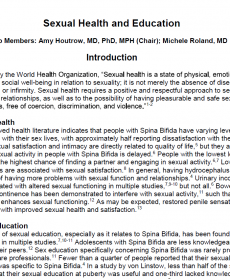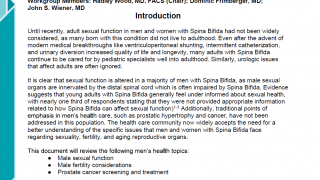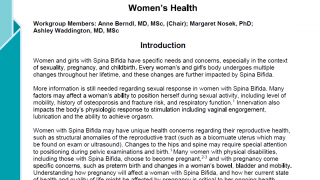Workgroup Members: Amy Houtrow, MD, PhD, MPH (Chair); Michele Roland, MD
Introduction
As stated by the World Health Organization, “Sexual health is a state of physical, emotional, mental and social well-being in relation to sexuality; it is not merely the absence of disease, dysfunction or infirmity. Sexual health requires a positive and respectful approach to sexuality and sexual relationships, as well as to the possibility of having pleasurable and safe sexual experiences, free of coercion, discrimination, and violence.”1-2
Sexual Health
Peer-reviewed health literature indicates that people with Spina Bifida have varying levels of satisfaction with their sex lives, with approximately half reporting dissatisfaction with their sex lives.3,4 Sexual satisfaction and intimacy are directly related to quality of life,5 but they are rarely studied. Sexual activity in people with Spina Bifida is delayed.6 People with the lowest lesion levels had the highest chance of finding a partner and engaging in sexual activity.6,7 Lower lesion levels are associated with sexual satisfaction.8 In general, having hydrocephalus was predictive of having more problems with sexual function and relationships.4 Urinary incontinence was associated with altered sexual functioning in multiple studies,7,9-10 but not all.6 Bowel and bladder incontinence has been demonstrated to interfere with sexual activity,11 such that continence enhances sexual functioning.12 As may be expected, restored penile sensation is associated with improved sexual health and satisfaction.13
Sexual Education
The receipt of sexual education, especially as it relates to Spina Bifida, has been found to be inadequate in multiple studies.7,10-11 Adolescents with Spina Bifida are less knowledgeable about sex than their peers.12 Sex education specifically concerning Spina Bifida was rarely provided by heath care professionals.11 Fewer than a quarter of people reported that their sexual education was specific to Spina Bifida.4 In a study by von Linstow, less than half of the subjects reported that their sexual education at puberty was useful and one-third lacked knowledge about how their sexual functioning was impacted by their disability.3
Both young men and young women wanted more information from their health care providers especially about sexual education specific to living with Spina Bifida.14 Young women with Spina Bifida want increased knowledge of fertility, birth control and heredity of Spina Bifida.15 In a qualitative study, the questions and concerns that youth with Spina Bifida reported fell into four themes: romantic relationships, sexuality, fertility/parenthood, and the need for more sexual education.16 Inadequate sexual education may explain why compared to healthy controls, people with Spina Bifida were less likely to use birth control when sexually active.17
There also needs to be more sexual counseling for people with Spina Bifida in order to increase their sexual satisfaction and quality of life.3 The lack of access to information about sexual health, training, and skill-building that is specific to people with Spina Bifida over their life span contributes to these knowledge gaps and suboptimal outcomes. It is important to provide people with Spina Bifida with opportunities to acquire relevant and accurate knowledge about sexual health, and to develop and implement skills to negotiate sexual desire, intimacy, and activity. Doing so can support healthy sexuality while limiting negative outcomes of sexual activity related to sexually transmitted infections, HIV transmission, unintended pregnancy, or sexual exploitation. Sexual education and health promotion has proven to specifically benefit youth by combining education with skill-development training.18
Outcomes
Primary
- Optimization of sexual health outcomes for people with Spina Bifida, leading to:
-
- Satisfaction with sexuality and sexual relationships.
- Knowledge of sexual health specific to Spina Bifida.
Secondary
- Maximization of the ability of adults with Spina Bifida to participate as desired in meaningful and fulfilling sexual relationships through the provision of accurate sexual health education across the life span.
Tertiary
- Empowerment of people with Spina Bifida to seek knowledge and skill-building regarding sexual relationships by way of the advancement of knowledge and comfort of health care professionals to provide them with sexual health education.
0 -11 months
Clinical Questions
- Is there evidence that prenatal closure impacts sexual function?
- Is there evidence that discussing the neurologic sequelae of Spina Bifida improves parent’s understanding of sexual health for their infant as they become an adult?
Guideline
- Educate parents and caregivers about the anticipated neurologic sequelae of Spina Bifida including how sexual functioning may be impacted and that sexuality is a part of life for everyone including people with disabilities. (clinical consensus)
1-2 years 11 months
Clinical Questions
- Should the timing of parental sexual education for children with Spina Bifida differ from that of typically-developing children?
- Does early sexual education improve sexual health outcomes or social adjustment for children with Spina Bifida?
Guidelines
- Educate parents and caregivers about the anticipated neurologic sequelae of Spina Bifida including how sexual functioning may be impacted. (clinical consensus)
- Educate parents and caregivers that sexuality is a part of life for everyone including people with disabilities. (clinical consensus)
- Provide factual information to parents and caregivers and encourage them to provide developmentally-appropriate sexual education to their children.20
- Explore the parent’s expectations regarding their child’s sexual development.21
- Explain that sexual exploration is a normal and healthy part of early childhood development.22
- Explain the importance of minimizing the child’s risk of sexual abuse through teaching children about their body parts, privacy, who may touch their bodies and what do to if inappropriate touching occurs.23
3-5 years 11 months
Clinical Questions
- What preschool activities promote healthy sexual development for children with Spina Bifida?
- How should health care professionals promote developmentally appropriate sexual education for young children with Spina Bifida?
Guidelines
- Provide factual information to parents and caregivers and encourage them to provide developmentally-appropriate sexual education to their children, including information about appropriate versus inappropriate touching.
- Explore the parent’s expectations regarding their child’s sexual development.25
- Explain that sexual exploration is a normal and healthy part of early childhood development.24
- Underscore the goal of continence (Bowel Function and Care Guidelines, Urology Guidelines) for optimal sexual relationships in the future. (clinical consensus)
- Review relevant literature that addresses sexual health and education, such as “Bright Futures” and other reports prepared by the American Academy of Pediatrics. 24,25,27
- Provide education about pubertal development, evaluate concerns or abnormal physical findings, and explain the risks of precocious puberty. (Endocrine: Puberty and Precocious Puberty)
6-12 years 11 months
Clinical Questions
- What should be taught to children with Spina Bifida regarding sexual health?
Guidelines
- Provide factual information to parents and caregivers and encourage them to provide developmentally-appropriate sexual education to their children.20,25
- Review relevant literature that addresses sexual health and education, such as “Bright Futures” and other reports prepared by the American Academy of Pediatrics. 20,24-25
- Allow the child to ask questions about sexual development and sexuality.24
- Serve as a resource to schools 24 to ensure that children with Spina Bifida participate in sexual education.
- Encourage parents to discuss information that their children are receiving about healthy relationships from school, their peers, the media, and social media.24
- Promote skill-building to identify dangerous situations, refuse or break off a sexual attack, and summon help.26
- Promote socially-appropriate behaviors and social skills.25
- Underscore the goal of continence (Bowel Function and Care Guidelines, Urology Guidelines) for optimal sexual relationships in the future (clinical consensus)
- Provide education about sexuality, pubertal development, evaluate concerns or abnormal physical findings, and explain the risks of precocious puberty (Endocrine: Puberty and Precocious Puberty Guidelines).20
13-17 years 11 months
Clinical Questions
- What should teens with Spina Bifida be taught about sexuality?
- How can healthy relationships be promoted for teens with Spina Bifida?
Guidelines
- Acknowledge that sexual health is an important part of life. (clinical consensus)
- Discuss healthy relationships in gender-neutral language as the teen years are the time when many achieve self-awareness about sexual orientation.24
- Educate teens about intimate partner violence and sexual assault.20
- Discuss safe-sex practices including the use of non-latex condoms to prevent sexually transmitted infections and unwanted pregnancies.4,24-25
- Refer to a women’s health provider such as a gynecologist, adolescent medicine specialist, or family medicine practitioner if the teen with Spina Bifida intends to become sexually active. Refer young men to a sexual function clinic if desired. (clinical consensus) (Men’s Health Guidelines, Women’s Health Guidelines)
- Ensure that the Guidelines for Adolescent Preventive Services are implemented.27
- Create an environment in which the teen feels comfortable and safe discussing sexual health, including being able to speak to them alone and confidentially.24
- Educate parents by presenting them with factual information and encourage them to provide developmentally appropriate sexual education to their children.20,25
- Encourage parents to discuss information that their children are receiving about healthy relationships from school, their peers, the media, and social media.24
- Discuss sexuality routinely and openly during health care visits, and acknowledge the fluidity of sexuality and gender.24
- Allow the teen to ask questions about sexual development and sexuality.24
- Serve as a resource to schools 24 to ensure that children with Spina Bifida participate in sexual education.
- Underscore the goal of continence (Bowel Function and Care Guidelines, Urology Guidelines) for optimal sexual relationships in the future. (clinical consensus)
- Provide education about pubertal development and evaluate pubertal development and any abnormal physical findings (Endocrine: Puberty and Precocious Puberty Guidelines).24
- Educate teens and parents regarding birth control options, pregnancy, genetic risk, and sexually transmitted infection risk associated with sexual activity including the use of non-latex barrier methods.15,24-25,28 (Men’s Health Guidelines, Women’s Health Guidelines)
18+ years
Clinical Questions
- How can the ability of adults with Spina Bifida to engage in meaningful and satisfying sexual relationships be maximized?
Guidelines
- Acknowledge that sexual health is an important part of adult life.1
- Take a history of sexual interest, functioning, experience and problems. (Men’s Health Guidelines, Women’s Health Guidelines, specifically information about fertility, reproduction, and anatomic functioning.)
- Use factual information to educate adults about sexual health including intimate partner violence and sexual assault. (clinical consensus)
- Provide guidance about safe sex practices including non-latex condoms to prevent sexually transmitted infections and unwanted pregnancies.20,24-25
- Refer to a women’s health provider such as a gynecologist, adolescent medicine physician or family medicine practitioner. Refer men to a sexual function clinic if desired. (clinical consensus) (Men’s Health Guidelines, Women’s Health Guidelines)
- Educate about heritability of Spina Bifida. (Men’s Health Guidelines, Women’s Health Guidelines)
- Create an environment in which the adult feels comfortable and safe discussing sexuality and sexual health routinely and openly during health care visits. (clinical consensus)
- Refer to support groups and general audience literature regarding disability and sexuality. (clinical consensus)
- Provide visual samples of items to facilitate discussions, such as female and male condoms, relevant websites, and other online resources. (clinical consensus)
- Educate about the role of self-examination and routine health maintenance visits. (clinical consensus) (Men’s Health Guidelines, Women’s Health Guidelines)
- Underscore goal of continence (Bowel Function and Care Guidelines, Urology Guidelines) for optimal sexual relationships. (clinical consensus)
Research Gaps
The research gaps regarding sexual health and functioning for people with Spina Bifida are extensive. Research is warranted to study:
- The impact of prenatal closure on sexual functioning.
- The best methods of providing sexual education.
- Strategies to promote sexual health and well-being.
- Whether sexual education improves safe sex practices.
- The barriers and factors that enhance sexual performance and satisfaction.
- Interventions that are geared toward improving the sexual health of people with Spina Bifida.
- The relationship of self-esteem, self-image, and self-worth with sexual health outcomes.
- The relationship between sexual health and quality of life.
References
- World Health Organization. Defining sexual health. Sexual and Reproductive Health 2006; http://www.who.int/reproductivehealth/topics/sexual_health/sh_definitions/en/.
- World Health Organization. International Classification of Functioning, Disability and Health Browser.2015 http://appswhoint/classifications/icfbrowser/
- von Linstow ME, Biering-Sorensen I, Liebach A, et al. Spina bifida and sexuality. J Rehabil Med 2014;46:891-7.
- Verhoef M, Barf HA, Vroege JA, et al. Sex education, relationships, and sexuality in young adults with Spina Bifida. Archives of physical medicine and rehabilitation 2005;86:979-87.
- Lee S, Fenge LA. Sexual Well-being and Physical Health. British Journal of Social Work 2016;0:1-19.
- Lassmann J, Garibay Gonzalez F, Melchionni JB, Pasquariello PS, Jr., Snyder HM, 3rd. Sexual function in adult patients with Spina Bifida and its impact on quality of life. J Urol 2007;178:1611-4.
- Gatti C, Del Rossi C, Ferrari A, Casolari E, Casadio G, Scire G. Predictors of successful sexual partnering of adults with Spina Bifida. J Urol 2009;182:1911-6.
- Lee NG, Andrews E, Rosoklija I, et al. The effect of spinal cord level on sexual function in the Spina Bifida population. Journal of pediatric urology 2015;11:142 e1-6.
- Game X, Moscovici J, Guillotreau J, Roumiguie M, Rischmann P, Malavaud B. Sexual function of young women with myelomeningocele. Journal of pediatric urology 2014;10:418-23.
- Cardenas DD, Topolski TD, White CJ, McLaughlin JF, Walker WO. Sexual functioning in adolescents and young adults with Spina Bifida. Arch Phys Med Rehabil 2008;89:31-5.
- Shiomi T, Hirayama A, Fujimoto K, Hirao Y. Sexuality and seeking medical help for erectile dysfunction in young adults with Spina Bifida. Int J Urol 2006;13:1323-6.
- de Vylder A, van Driel MF, Staal AL, Weijmar Schultz WC, Nijman JM. Myelomeningocele and female sexuality: an issue? Eur Urol 2004;46:421-6; discussion 6-7.
- Overgoor ML, de Jong TP, Cohen-Kettenis PT, Edens MA, Kon M. Increased sexual health after restored genital sensation in male patients with Spina Bifida or a spinal cord injury: the TOMAX procedure. J Urol 2013;189:626-32.
- Heller MK, Gambino S, Church P, Lindsay S, Kaufman M, McPherson AC. Sexuality and Relationships in Young People With Spina Bifida and Their Partners. J Adolesc Health 2016;59:182-8.
- Visconti D, Noia G, Triarico S, et al. Sexuality, pre-conception counseling and urological management of pregnancy for young women with Spina Bifida. Eur J Obstet Gynecol Reprod Biol 2012;163:129-33.
- Akre C, Light A, Polvinen J, Rich M. What young people with Spina Bifida want to know about sex and are not being told. CHild Care Health and Development 2016;6:963-9.
- Cromer BA, Enrile B, McCoy K, Gerhardstein MJ, Fitzpatrick M, Judis J. Knowledge, attitudes and behavior related to sexuality in adolescents with chronic disability. Dev Med Child Neurol 1990;32:602-10.
- Kirby D. Sexuality education: a more realistic view of its effects. The Journal of school health 1985;55:421-4.
- Lee NG, Gomez P, Uberoi V, et al. In utero closure of myelomeningocele does not improve lower urinary tract function. J Urol 2012;188:1567-71.
- Murphy NA, Elias ER. Sexuality of children and adolescents with developmental disabilities. Pediatrics 2006;118:398-403.
- National Guidelines Task Force. Guidelines for comprehensive sexuality education: kindergarten through 12th grade. Reviewers: Gelperin N, Goldfarb ES, Hemich J, Kelly MA, Schoeder E . 2004;http://sexedu.org.tw/guideline.pdf:1-109.
- Hagan JF, Shaw JS, Duncan PM, Bright Futures., American Academy of Pediatrics. Bright futures : guidelines for health supervision of infants, children, and adolescents 3rd ed. Elk Grove, IL: American Academy of Pediatrics; 2008.
- American Academy of Pediatrics. Preventing and Identifying Child Sexual Abuse – Tips from the American Academy of Pediatrics. AAP org 2011;11/2011
- Hagan JF, Shaw JS, Duncan PM, Bright Futures., American Academy of Pediatrics. Bright futures : guidelines for health supervision of infants, children, and adolescents 3rd ed. Elk Grove, IL: American Academy of Pediatrics; 2008.
- Breuner CC, Mattson G, Committee On A, Committee On Psychosocial Aspects Of C, Family H. Sexuality Education for Children and Adolescents. Pediatrics 2016;138.
- Finkelhor D. The prevention of childhood sexual abuse. Future Child 2009;19:169-94.
- Montalto NJ. Implementing the guidelines for adolescent preventive services. Am Fam Physician 1998;57:2181-8, 9-90.
- National Guidelines Task Force. Guidelines for comprehensive sexuality education: kindergarten through 12th grade. Reviewers: Gelperin N, Goldfarb ES, Hemich J, Kelly MA, Schoeder E . 2004;http://sexedu.org.tw/guideline.pdf:1-109.
Tags



